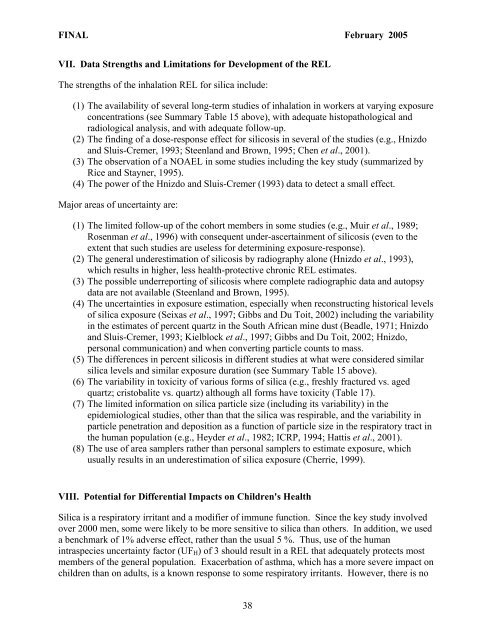Silica (crystalline, respirable) - OEHHA
Silica (crystalline, respirable) - OEHHA
Silica (crystalline, respirable) - OEHHA
Create successful ePaper yourself
Turn your PDF publications into a flip-book with our unique Google optimized e-Paper software.
FINAL February 2005<br />
VII. Data Strengths and Limitations for Development of the REL<br />
The strengths of the inhalation REL for silica include:<br />
(1) The availability of several long-term studies of inhalation in workers at varying exposure<br />
concentrations (see Summary Table 15 above), with adequate histopathological and<br />
radiological analysis, and with adequate follow-up.<br />
(2) The finding of a dose-response effect for silicosis in several of the studies (e.g., Hnizdo<br />
and Sluis-Cremer, 1993; Steenland and Brown, 1995; Chen et al., 2001).<br />
(3) The observation of a NOAEL in some studies including the key study (summarized by<br />
Rice and Stayner, 1995).<br />
(4) The power of the Hnizdo and Sluis-Cremer (1993) data to detect a small effect.<br />
Major areas of uncertainty are:<br />
(1) The limited follow-up of the cohort members in some studies (e.g., Muir et al., 1989;<br />
Rosenman et al., 1996) with consequent under-ascertainment of silicosis (even to the<br />
extent that such studies are useless for determining exposure-response).<br />
(2) The general underestimation of silicosis by radiography alone (Hnizdo et al., 1993),<br />
which results in higher, less health-protective chronic REL estimates.<br />
(3) The possible underreporting of silicosis where complete radiographic data and autopsy<br />
data are not available (Steenland and Brown, 1995).<br />
(4) The uncertainties in exposure estimation, especially when reconstructing historical levels<br />
of silica exposure (Seixas et al., 1997; Gibbs and Du Toit, 2002) including the variability<br />
in the estimates of percent quartz in the South African mine dust (Beadle, 1971; Hnizdo<br />
and Sluis-Cremer, 1993; Kielblock et al., 1997; Gibbs and Du Toit, 2002; Hnizdo,<br />
personal communication) and when converting particle counts to mass.<br />
(5) The differences in percent silicosis in different studies at what were considered similar<br />
silica levels and similar exposure duration (see Summary Table 15 above).<br />
(6) The variability in toxicity of various forms of silica (e.g., freshly fractured vs. aged<br />
quartz; cristobalite vs. quartz) although all forms have toxicity (Table 17).<br />
(7) The limited information on silica particle size (including its variability) in the<br />
epidemiological studies, other than that the silica was <strong>respirable</strong>, and the variability in<br />
particle penetration and deposition as a function of particle size in the respiratory tract in<br />
the human population (e.g., Heyder et al., 1982; ICRP, 1994; Hattis et al., 2001).<br />
(8) The use of area samplers rather than personal samplers to estimate exposure, which<br />
usually results in an underestimation of silica exposure (Cherrie, 1999).<br />
VIII. Potential for Differential Impacts on Children's Health<br />
<strong>Silica</strong> is a respiratory irritant and a modifier of immune function. Since the key study involved<br />
over 2000 men, some were likely to be more sensitive to silica than others. In addition, we used<br />
a benchmark of 1% adverse effect, rather than the usual 5 %. Thus, use of the human<br />
intraspecies uncertainty factor (UFH) of 3 should result in a REL that adequately protects most<br />
members of the general population. Exacerbation of asthma, which has a more severe impact on<br />
children than on adults, is a known response to some respiratory irritants. However, there is no<br />
38















